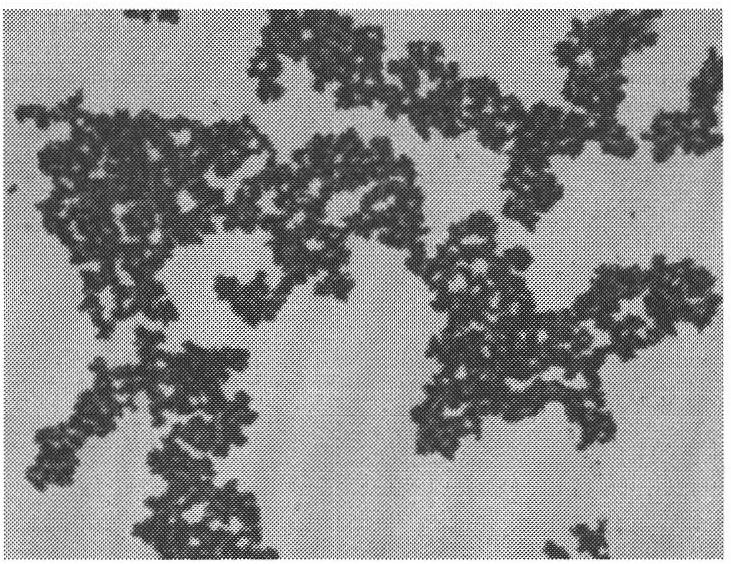Kit for separating genome DNA by using magnetic balls and application thereof
A magnetic bead separation and genome technology, applied in the biological field, can solve the problems of high price and achieve the effects of easy transportation, good safety and high yield
- Summary
- Abstract
- Description
- Claims
- Application Information
AI Technical Summary
Problems solved by technology
Method used
Image
Examples
Embodiment 1
[0055] Example 1: Preparation of Genomic DNA Separation Kit with Magnetic Beads
[0056] This embodiment includes the following steps:
[0057] 1) Preparation of magnetic balls: uniform, superparamagnetic, single-divergent polymagnetic balls were synthesized using ferric ammonium sulfate and ferrous ammonium sulfate as materials. 9.6g ferric ammonium sulfate, 3.0g ferrous ammonium sulfate were dissolved in 25ml water and 1ml concentrated hydrochloric acid respectively. Put the above solution into a three-necked flask, blow nitrogen gas, stir at 1000rpm, and add 26ml of concentrated ammonia water dropwise for about 30 minutes, continue nitrogen flow, stir for about one hour and stop stirring. After the reaction is complete, wash with water several times to remove tiny particles. During this process, the temperature of the three-necked flask was kept at about 50 degrees. 2) Modified ligand of magnetic spheres: Take a certain amount of magnetic fluid in a three-necked flask. W...
Embodiment 2
[0059] Example 2: Application of this kit to isolate poplar leaf genomic DNA and DNA enzyme digestion detection
[0060] Genomic DNA of poplar leaves was isolated using the kit described in Example 1 and detected by enzyme digestion experiments. This example includes the following steps:
[0061] 1) Genomic DNA extraction: ① Take 50 mg of plant tissue and grind it with liquid nitrogen. ② Add 450 μl of cell lysate and bathe in water at 65°C for 30 minutes. ③Add 300μl binding solution, mix gently, and centrifuge at 12000rpm to remove the precipitate. ④ Add 50 μl of magnetic beads, mix gently, and keep the magnetic beads in suspension for 5 minutes. ⑤ Place the centrifuge tube on the magnetic rack and remove the liquid. ⑥ Add 800 μl of washing solution A, mix gently, put the centrifuge tube on the magnetic rack, and remove the liquid. ⑦Add 800μl washing solution A, mix gently, put the centrifuge tube on the magnetic rack, and remove the liquid. ⑧ Dry at room temperature for...
Embodiment 3
[0072] Example 3 Using this kit to isolate mouse muscle tissue DNA and perform fluorescence quantitative PCR detection
[0073] The kit described in Example 1 was used to isolate mouse muscle tissue genomic DNA and perform fluorescent quantitative PCR experiment detection. This example includes the following steps:
[0074] 1) Genomic DNA extraction: ① Take 50 mg of mouse muscle tissue and grind it with liquid nitrogen. ② Add 450 μl of cell lysate, 10 μl of proteinase K (20 mg / ml), 10 μl of RNase A, and bathe in water at 58°C for 30 minutes. ③Add 300μl binding solution, mix gently, and centrifuge at 12000rpm to remove the precipitate. ④ Add 50 μl of magnetic beads, mix gently, and keep the magnetic beads in suspension for 5 minutes. ⑤ Place the centrifuge tube on the magnetic rack and remove the liquid. ⑥ Add 800 μl of washing solution A, mix gently, put the centrifuge tube on the magnetic rack, and remove the liquid. ⑦Add 800μl washing solution A, mix gently, put the cen...
PUM
| Property | Measurement | Unit |
|---|---|---|
| diameter | aaaaa | aaaaa |
Abstract
Description
Claims
Application Information
 Login to View More
Login to View More - R&D
- Intellectual Property
- Life Sciences
- Materials
- Tech Scout
- Unparalleled Data Quality
- Higher Quality Content
- 60% Fewer Hallucinations
Browse by: Latest US Patents, China's latest patents, Technical Efficacy Thesaurus, Application Domain, Technology Topic, Popular Technical Reports.
© 2025 PatSnap. All rights reserved.Legal|Privacy policy|Modern Slavery Act Transparency Statement|Sitemap|About US| Contact US: help@patsnap.com



